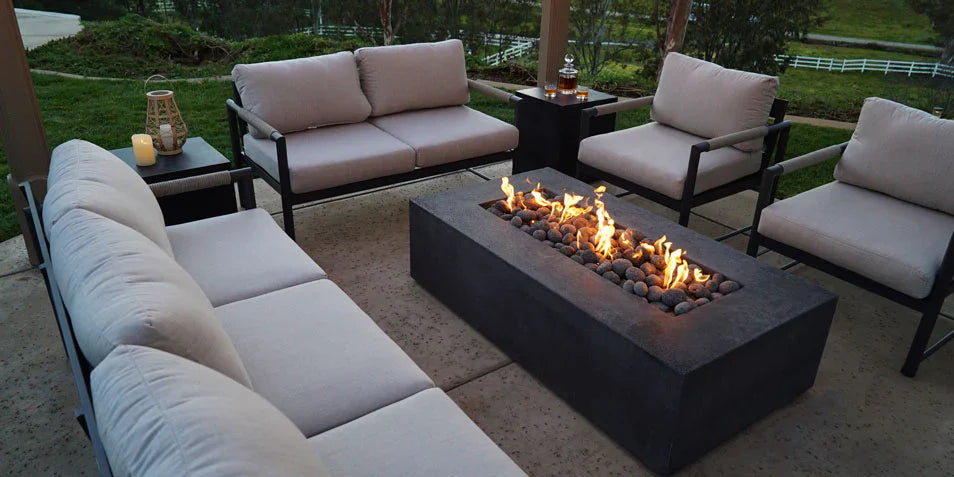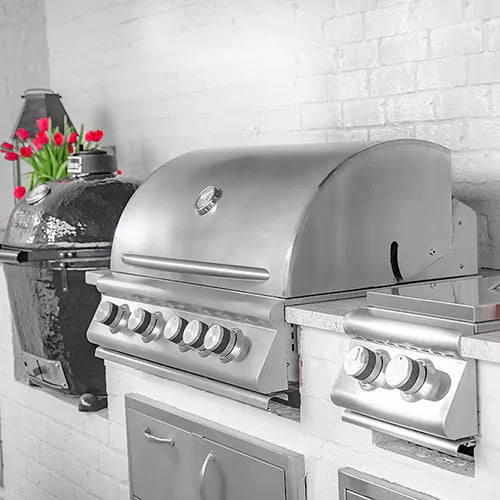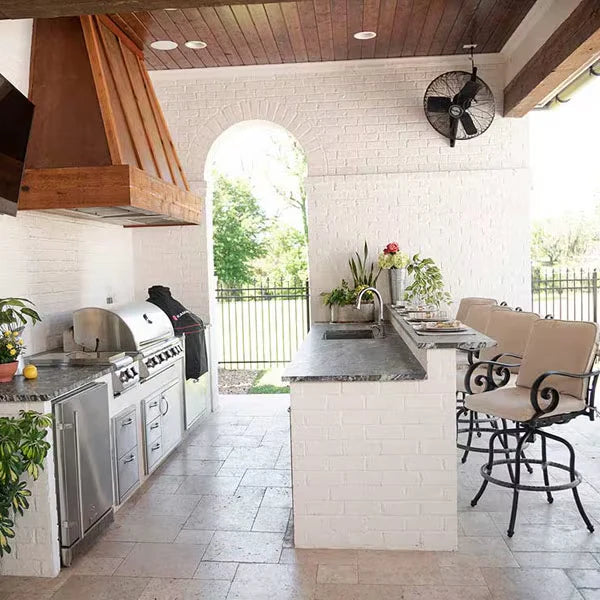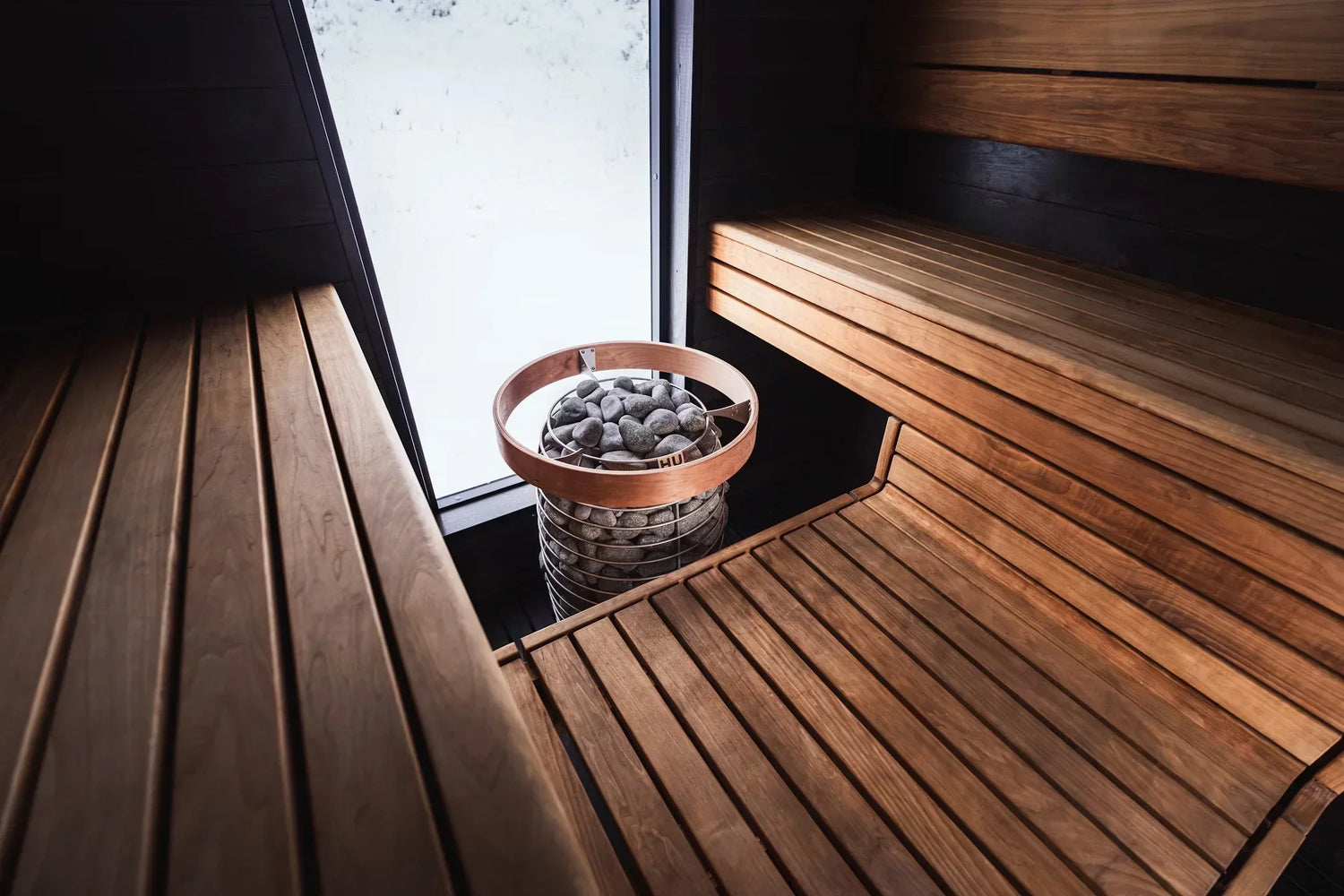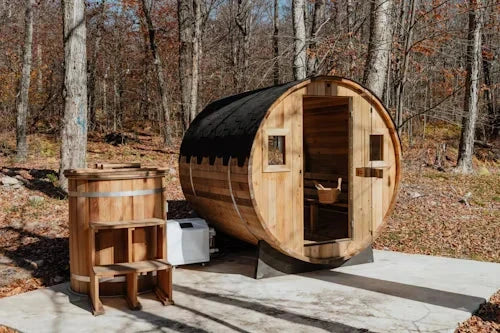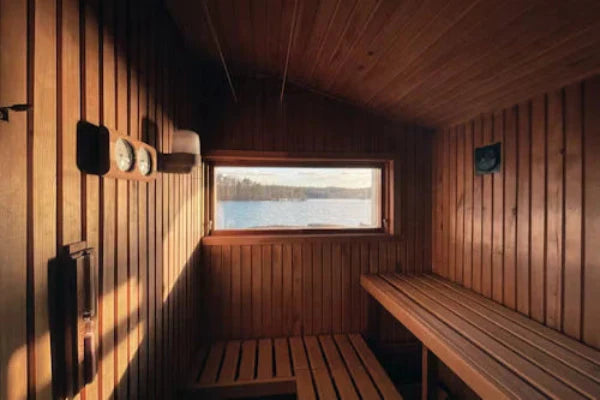The Basics of How Both Fuel Types Work in Outdoor Fire Tables
Before we get into the pros and cons, let’s break down how gas fire tables work because whether they run on propane or natural gas, the process is basically the same.
Gas flows from your tank or line through a control valve, hits a burner hidden beneath the media (usually lava rock or fire glass), and is sparked by an ignition source.
The result? Controlled, consistent flames without having to chop wood or clean up the leftover ash.
Both fuel types make it easy to enjoy instant heat and ambiance, but the way they connect and burn is where things start to differ.
Let’s get into that next.
What is a Propane Fire Table?
A propane fire table uses a portable fuel source, typically a common 20-pound tank. The tank is usually stored inside the table’s base or tucked beside it in a matching cover. Since it runs on propane, no external gas lines are needed, making it easy to set up and move around.
What is a Natural Gas Fire Table?
A natural gas fire table connects directly to your home's gas line, making it a permanent installation. It typically requires professional setup to ensure safety and code compliance. The biggest perk is an unlimited fuel supply with no need for refills.
Propane Fire Table Outdoor Setups — Pros, Cons, and Who It’s Best For
Propane fire tables are one of the most popular choices for outdoor heating for good reason. In this section, we’ll break down what makes them so appealing, what to consider before buying, and how they compare to other fuel options when it comes to style, setup, and everyday use.
Pros of Propane Fire Tables
Propane fire tables offer a level of portability and flexibility that’s hard to beat. They’re clean-burning, with strong, adjustable flames and no ash or smoke to deal with. Since there’s no need for a permanent gas line, you can skip permits and professional installation.
They also work well in remote or off-grid spaces, making them great for cabins, campsites, or backyards without gas hookups.
Plus, swapping out propane tanks is simple, and many designs include hidden tank enclosures to keep things looking sleek.
Cons of Propane
While propane fire tables are convenient, they come with a few trade-offs. Tanks need to be refilled or exchanged, and frequent use can burn through fuel quickly. That often means spending extra time and money traveling to refill stations or exchange centers.
Propane also costs more per BTU compared to natural gas, and visible tanks can disrupt the look of your space if not properly concealed.
Opting for a fire pit with hidden tank storage and keeping a backup tank on hand can make these downsides much easier to live with.
Who Should Consider Propane
Propane fire tables are a great choice for anyone who values portability and hassle-free setup.
They're ideal for seasonal use, renters, or anyone who doesn’t want to deal with contractors, gas lines, or digging trenches.
With sleek designs and hidden tank options, they're especially popular with design-forward buyers who want both function and style.
If you’re looking for a fire feature that’s easy to move, quick to install, and clean to operate, propane is a solid fit.
Natural Gas Fire Tables — Strong, Seamless, and Built to Stay
If you’ve got a dedicated outdoor living space and want something reliable for the long haul, a natural gas fire table is worth a serious look. This section covers the key benefits, potential drawbacks, and why natural gas is a favorite for homeowners who want a permanent setup, low fuel costs, and zero tank refills. It’s all about long-term ease with a clean, consistent flame that’s always ready to go.
Pros of Natural Gas
Natural gas fire tables offer unlimited fuel, so you’ll never have to worry about running out or making last-minute refill runs.
They’re also more cost-effective over time, especially if you use your fire pit often or have a larger setup.
Natural gas tends to burn more evenly, providing consistent heat and flame quality with fewer fluctuations. It’s also a cleaner-burning option, producing lower emissions compared to wood or even propane.
For homeowners looking for long-term convenience and steady performance, natural gas is a smart, low-maintenance choice.
Cons of Natural Gas
Natural gas fire tables come with a few important considerations. They require professional installation to connect to your home’s gas line, which means a higher upfront cost compared to propane setups.
Since they're fixed in place, you won’t be able to move them once installed, making them better suited for permanent outdoor living spaces.
You may also need to secure city permits or HOA approval, depending on your location. And while the flame is clean and steady, it can appear smaller or less vibrant in daylight, especially compared to propane or wood-burning options.
Who Should Consider Natural Gas
Natural gas fire tables are ideal for homeowners with a fixed patio or outdoor living area who want a permanent, reliable setup.
They’re best suited for frequent users, the kind of people who burn their fire pit for hours at a time and don't want to worry about running out of fuel.
If you're after low ongoing costs and a true “set it and forget it” experience, natural gas delivers. Just keep in mind, this option isn’t great for renters or anyone who plans to move seasonally, since it’s a built-in solution meant to stay put.
Hidden Tank Designs, Dual-Fuel Systems, and Modern Aesthetics
Not all fire pits fit neatly into one category. Many of today’s premium models blur the lines between propane and natural gas setups, offering sleek hidden tank storage, dual-fuel compatibility, and modern aesthetics that elevate any space.
Hidden Tank Fire Tables (Best of Both Worlds)
Hidden tank fire tables offer the clean, modern look of a built-in setup with the flexibility of propane. By keeping the tank tucked out of sight, they instantly elevate the overall design and reduce trip hazards or exposed parts.
These models blend seamlessly with a wide range of outdoor furniture styles, making them a favorite for design-conscious buyers who want both style and simplicity.
Dual-Fuel + Conversion Kits
Many modern fire tables are designed with dual-fuel flexibility, meaning they can run on propane now and switch to natural gas later if your setup changes.
This makes them ideal for future-proofing your space, especially if you’re planning to upgrade to a built-in gas line down the road.
With the right conversion kit, you won’t need to invest in a whole new fire table, just swap the components and keep the style you already love.
Fire Table Propane Trends
Propane continues to lead in luxury fire table design, thanks to its portability and easy setup. It remains the top choice for homeowners who want a clean look without the commitment of a built-in gas line.
Popular styles include round and rectangular tables paired with lava rock or fire glass media for a modern, elevated vibe. As more buyers prioritize aesthetics and low-maintenance convenience, propane fire tables are becoming the go-to for stylish, flexible outdoor setups.
A Head-to-Head Comparison of Propane vs Natural Gas
If you're torn between propane and natural gas, this quick chart breaks down the key differences at a glance. Whether you're after flexibility, long-term savings, or sleek design, here’s how each option stacks up.
|
Feature |
Propane |
Natural Gas |
|
Installation |
No permanent setup needed |
Requires professional installation |
|
Portability |
Highly portable |
Fixed in place |
|
Fuel Access |
Tank-based, needs refills or exchange |
Continuous fuel from home supply |
|
Ongoing Cost |
Slightly higher per use |
Lower long-term fuel cost |
|
Setup Time |
Plug-and-play ready |
Takes longer due to gas line work |
|
Design Options |
Wide variety, many hidden tank models |
Fewer design-forward portable options |
|
Best For |
Renters, seasonal use, design flexibility |
Permanent patios, heavy long-term use |
Still Can’t Decide? Here’s How to Choose the Right One for You
If you're stuck between propane and natural gas, here's a quick way to figure out what fits your space, lifestyle, and priorities best:
-
Want to move your setup or take it with you? Go propane.
-
Already have a gas line or love long burn sessions? Go natural gas.
-
Hoping to skip permits, digging, and contractors? Propane is plug-and-play.
-
Never want to deal with tank refills again? Natural gas is the winner.
Think about how you’ll actually use your fire pit, then pick the option that makes your life easier, not harder.
Why Trust Active Oasis for Your Fire Table Decision
Choosing the right fire table shouldn’t feel overwhelming, and that’s where we come in. At Active Oasis, we carry both propane and natural gas models, with a focus on hidden tank designs and dual-fuel flexibility that blend function with style.
Every table we offer is tested for real backyard performance, so you’re not just getting looks, you’re getting lasting quality.
Need more help deciding? Reach out anytime and our team will walk you through sizing, style, and the fuel setup that fits your space best.
